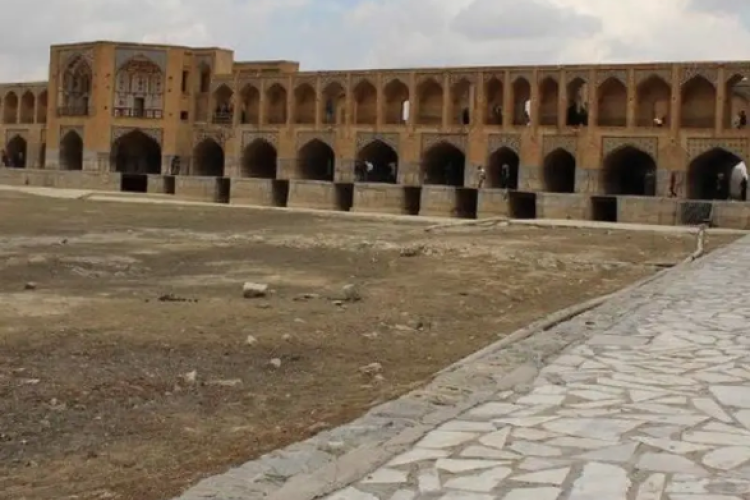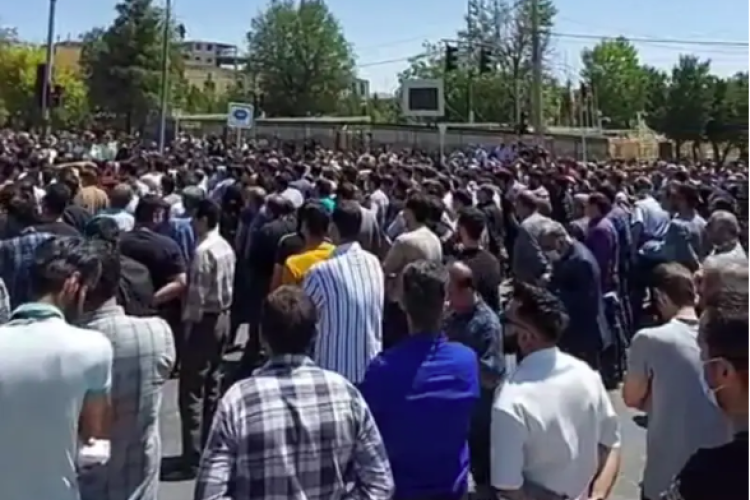Hundreds of residents in the southeastern city of Zabol protest against the Iranian government's failure to tackle the water crisis on July 31 2023
This statement, prepared by ArcDH, addresses the issue of access to "water and sanitation for all," as per Agenda 2030 of Sustainable Development Goal 6 (SDG6) with reference to the lack of performance by the Islamic Republic of Iran and the impact on its minority nations, particularly the nation of Azerbaijan in Azerbaijani provinces in Iran (the Azerbaijanis). This is against a background where the minority nations in the country know that access to safe drinking water and sanitation is their human right, but they are deprived of it. The information presented below lays down the facts for you to establish if the Islamic Republic of Iran is deliberately negligent towards its minority nations and the Azerbaijanis by violating their human rights to safe drinking water and sanitation and by not putting in place a water governance system towards the 17 SDGs to ensure their sustainability.
Key Features of the UN Governance on Water
Long gone are the days when water supply was local, and each locality adapted to its local means. Now water resources planning is one of the chief responsibilities of each state and each state has to remodel their water supply systems to meet SDG6 and to comply with the human right to safe drinking water and sanitation. This is only possible through effective planning systems, and seeks inclusivity among all stakeholders, all social sectors, all environmental spheres and never one against another.
Overview of Water Resources in Iran: If SDG6 is to be complied with, Iranian authorities needed to put in place proactive planning systems that reflect the diversity of geophysical and hydrometeorological patterns and be inclusive with its multinational divisions. The Iranian system of water provisions is a command-driven system, submissive to collusions among different government departments and corruption, with the ability to overrule, overwrite or override any decision at any time. There is no planning system in Iran in the true sense of aiming to balance public and private development needs mandated with the protection of amenities and the environment through management, control and regulation enshrined by appropriate policies.
Iranian policy priorities on self-sufficiency are the only major driver, which overburdens water resources. Should there be a water governance system in Iran, it should consider inclusively:
- Its internal drivers e.g., droughts; population growth; urbanization and migration dynamics of minority nations.
- Its external drivers e.g., pressures from rising living standards; inefficient water usage infrastructure for water supply; better water quality.
The above is not a mere claim but is supported by official statistics released by the Ministry of Energy, which informs that water demand in the whole country per sector is: 90% for agriculture, 8% for drinking water and 2% for industry and mining (https://www.irna.ir/news/84062923). Driven by the goal of self-sufficiency, Iranian authorities closed their eyes to deep wells being driven throughout the country, although a few unlikely farmers were prosecuted. This was contrary to the agreement with the UNDP (United Nations Development Plan), which helped Iran to implement a regulatory system of wells and monitor their operations towards sustainability.
The outcome of not having an inclusive water governance system is that the Islamic Republic of Iran is nowhere near reaching universal access to drinking water, sanitation and hygiene by 2030 Although steps have been taken to meet the needs of central provinces, this was through trans-catchment diversion infrastructures at the expense of marginal provinces. This gave rise to the Water Protests of 2018 in Iran, which exposed the non-inclusive nature of policymaking in Iran. Central government exploits and wrecks the natural resources, including water, of marginalized nation states and undermines their very existence. Let us consider the impacts on water resources in Azerbaijani provinces.
Crisis in Domestic Water Supply in Azerbaijani Provinces in Iran
Domestic water supplies in the Azerbaijani provinces are now in crisis. We have received reports on acute water shortages from many cities, towns and villages and in some cases, fights have led to a loss of life. Next excerpts are presented from news coverages to reflect the dimensions of the problem.
The land of the Azerbaijani provinces in Iran comprises of mountains, numerous wadis and vast plains with enough water resources to adopt sustainable water practices and maintain them if not wrecked by Iranian authorities. Malpractices in water resources management have caused not only Lake Urmia to disappear in two decades, but Azerbaijanis to be stressed in urban and rural areas by water shortages and frequent cutoffs of their supplies. Yet, Iranian authorities supply uninterrupted water to artificial forests in Eynali Mountain near Tabriz and to the City Park of Urmia, both of which are not older than 2 decades or so and derive their water from embankments against Lake Urmia. The absence of inclusive water governance gives the Iranian authority every leverage to manipulate even the supply of water in a gross violation of SDG6. The following examples from Tabriz help to illustrate the problems.
Tabriz, the historic capital of Azerbaijan and now the capital city of East Azerbaijan province, has a population of 1,900,000 according to official statistics, which naturally excludes its 1,000,000 marginalized inhabitants. The statistics of 1998 indicates that 80% of its water demand is sourced from Jighati Chay (Zarrinehrud), located 180 km to its southeast, supplying 2 million cubic meters annually (MCM/year). The remaining 20% of the water is sourced from Nehend reservoir in the north of Tabriz, as well as the wells of the Sehend mountain range (https://www.boma.news/fa/tiny/news-425293).
However, Tabriz is faced with successive water outages in summer seasons, as government officials alter the drinking water allocated to Tabriz and divert its large proportions to petrochemical industries and other industries.
In summer 2023, townships in north Tabriz are frequently facing water outages and sometimes these can last days in Baghmeshe, Irem, Venek, Veliesr and others, which are left to their own means to resolve their problems. Authorities in the region informed them that the supplies at Nehend reservoir have run out. The residents took to the street to protest against the denial of their right of access to drinking water holding empty 20-liter water containers, chanting slogans against the water authorities and the leader of the country. In the following days, residents of the northern districts in Tabriz rallied their protests in front of the governorate and the office of water authority. Although water authorities promised to investigate, their grievances are not abating (httpsV/www.radiofarda.com/a/tabriz-protests- watershrotages/32538565.html).
In August 2023, for several days, water outage problems hit residents of more than 280,000 people in Baghmeshe, Nesr, Rushdiye, Veli-Emr, Fereshte, Irem and 50% of the Veliesr district. They protested against the problem on the 7th and 14th of August in Venek Baghmeshe Square and chanted slogans "Su, Su" (water, water) and demanded a supply of water to their homes. Tactically, the East Azerbaijan governor sympathized with the protestors to calm them down but this was just lip service with no concrete action. Standing face-to-face with protesters, he reportedly sought to vindicate himself by saying that water authorities have lied both to the people and misreported the situation to its higher authorities and should be held accountable for their actions
ArcDH receives reports, which show that operatives of the Ministry of Intelligence repeatedly telephone environmental activists in Tabriz and threaten them with long-term prison sentences should they dare to protest over water shortages or the disaster of Lake Urmia. Renowned Azerbaijani activists have suffered prosecutions by Iranian authorities by arrest or detention, including Mrs. Nigar Khiyavi, a poetess, writer and translator, and Mrs. and Mrs. Ruqeyye Kabiri (writer),, charged with participating in protests of Azerbaijani women.
Policy malpractices by the Islamic Republic of Iran turn Azerbaijani provinces with good water potential into deserts. For instance, beet and alfalfa are water-intensive crops/products but the West Azerbaijan governor sponsored 5 beet-based sugar factories in West Azerbaijan, which also supply beet to sugar factories in Isfahan and Khorasan. The government also sponsors alfalfa crops in East Azerbaijan to produce feed for Tehran and Isfahan livestock farms.
Concluding Remarks
The Islamic Republic of Iran has set neither any precedence for commitments to any inclusive increases in water sector investments towards minority nations nor towards their capacity- building for sustainable drinking water. There is no detectable signal that Iranian authorities are minded whatsoever towards SDG6 for the minority nations. Evidence-based actions in Iran are superficial and not solutions for the population; therefore whatever water management they report for minority nations are fiction. The United Nations need to rethink its approach towards Iranian authorities by directly involving each and all minority nations as stakeholders. In this way, at least their voice will be heard.
United Nations
General Assembly
Distr.: General
XX May 2023
English only
Human Rights Council
Fifty-fourth session
11 September – 13 October 2023
Agenda item 5
Human rights bodies and mechanisms
Written statement submitted by Association pour la défense des droits de l'homme et des revendications démocratiques/culturelles du peuple Azerbaidjanais-Iran – „ARC“ (Association for the defense of human rights and democratic/cultural demands of the Azerbaijani-Iranian people - “ARC”), a non-governmental organization in special consultative status
The Secretary-General has received the following written statement which is circulated in accordance with Economic and Social Council resolution 1996/31
[22 August 2023]
List of photographs:
[1] Hundreds of residents in the southeastern city of Zabol protest against the Iranian government's failure to tackle the water crisis on July 31 2023. Source: RFE/RL’s Radio Farda
[2] The dry river bed of Zayandeh Rud in the city of Esfahan Sunday, 15 October 2023. Source: Iran International
[3] Protesters in the city of Shahrekord in Chaharmahal-Bakhtiari province on August 16, 2022. Source: Iran International


